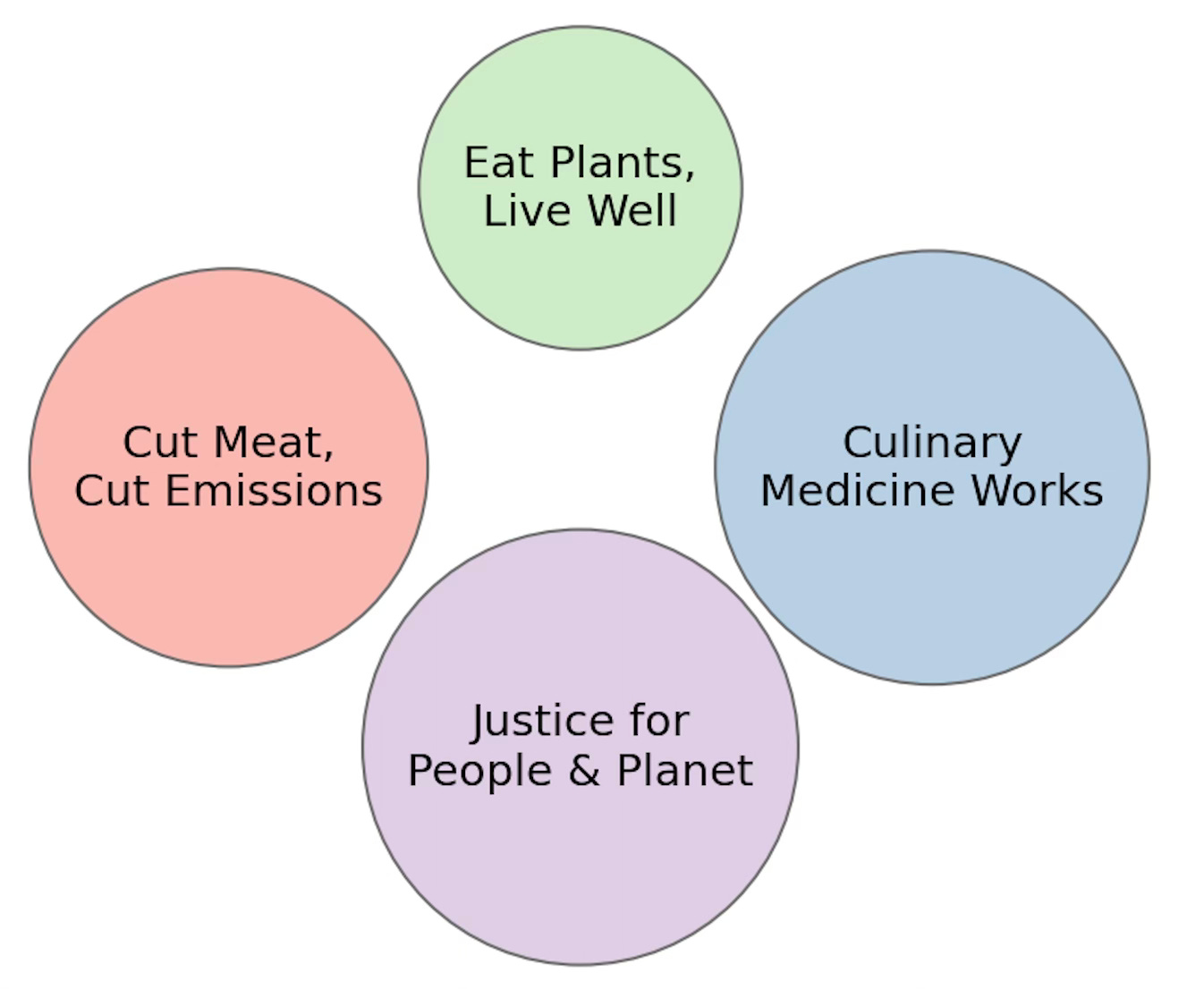Review of the plant-based nutrition and lifestyle medicine news September 2025
This month I share research on food as medicine, chronic disease prevention, and the environmental case for plants.

Plant-Based Diets and Diabetes
We have known for a while that high quality plant-based diets, including vegetarian and vegan, are associated with a lower risk of developing type 2 diabetes. This is in part, although not entirely, due to the fact the plant-based diets are associated with a healthier body weight. This new analysis from the UK-based EPIC-Norfolk prospective cohort assessed the impact of the Planetary Health Diet (>85% of energy is derived from plant-based foods) on the incidence of type 2 diabetes. With 23,722 participants and a median follow-up of 19.4 years, the results confirmed that people who are most adherent to this plant-based and sustainable way of eating had a 32% reduced risk of developing type 2 diabetes. This was after adjusting for confounders such as energy intake and adiposity.
A new analysis from the UK Biobank followed nearly 5,000 people with established type 2 diabetes for more than 11 years to see how adherence to different types of plant-based dietary patterns affected survival. The researchers found that people with the highest adherence to an overall plant-based diet had a significantly lower risk of death compared with those with the lowest adherence. The benefit was clearest when the diet emphasised whole plant foods such as vegetables, fruits, legumes, whole grains, and nuts. In contrast, people whose plant-based diets were dominated by refined grains, sugary drinks, and desserts actually faced a higher risk of mortality.
The protective association was particularly marked among those with more advanced or poorly controlled diabetes i.e people with higher HbA1c levels, larger waist circumferences, younger age at diagnosis, or longer disease duration. This suggests that a shift towards a healthy plant-based diet may be most impactful in higher-risk groups. Interestingly, the findings were stronger than those reported in studies of the general population, probably reflecting the greater potential for dietary change to offset the elevated risk carried by people with diabetes.
The study adds weight to existing evidence that quality matters: not all plant-based diets confer benefit. Diets rich in whole, minimally processed plants appear to extend survival, while unhealthy versions have the opposite effect. Most national and international guidelines recommend fibre-rich, plant-predominant diets for prevention, management and remission of type 2 diabetes, alongside other healthy lifestyle habits, including the American College of Lifestyle Medicine
Plant-Based Diets and Multimorbidity
This large prospective analysis pooled 407,618 adults from the EPIC (European Prospective Investigation into Cancer and Nutrition) and UK Biobank studies to test whether the quality of plant-based eating influences the path from being disease-free to developing two or more of cancer, cardiovascular disease (CVD), and type 2 diabetes. Diet quality was scored with a healthful plant-based diet index favouring whole grains, legumes, fruit, vegetables and nuts, and an unhealthful index emphasising refined grains, sweets and sugary drinks. Over roughly 11 years, 6,604 people developed multimorbidity (2 or more chronic diseases in the same person). Each 10-point higher healthful score was linked to a lower risk of becoming multimorbid – 11% reduction in EPIC and 19% reduction in UK Biobank – and this protective association also showed up consistently for first events of cancer, CVD and type 2 diabetes. By contrast, higher unhealthful scores tracked with more multimorbidity in UK Biobank (22% increase per 10 points) but were null in the EPIC study, although unhealthful scores were generally associated with higher risks of first cancer and CVD in both cohorts.
Age modified the benefits modestly: the healthful pattern was protective in both groups but a bit stronger under age 60 in UK Biobank with a similar though weaker pattern in EPIC. Adjusting for BMI barely changed the results, suggesting effects beyond weight alone. The authors conclude that diets centred on minimally processed plant foods, with small amounts of animal foods, may help prevent the accumulation of major chronic conditions into older age, while “plant-based” patterns built on refined, sugary foods may not.
This is now one of many studies that have associated plant-based eating patterns with healthy ageing and with plant sources of protein being one of the key elements.
Diet and Prostate Cancer
We have know for a while that diet and lifestyle approaches are beneficial for preventing and managing prostate cancer. Dr Dean Ornish was one of the first to demonstrate the ability to slow the progression of early stages of prostate cancer by using his plant-based lifestyle intervention.
This new comprehensive systematic review brings together evidence from 49 prospective cohort studies and 14 randomised trials to evaluate how whole dietary patterns influence prostate cancer risk, progression, and mortality. For men without prostate cancer, healthier patterns, whether described as plant-based, Mediterranean, or aligned with indices like the Healthy Eating Index or World Cancer Research Fund/American Institute of Cancer Research guidelines, were generally linked to lower overall or fatal cancer risk, although results were mixed for Mediterranean diet adherence. Diets high in processed meat, refined grains, sugars, or with high inflammatory or insulinemic potential tended to increase risk.
Among men already diagnosed with prostate cancer, the evidence was clearer and more consistent: Mediterranean, plant-based, and low-inflammatory dietary patterns were associated with reduced disease progression and prostate cancer–specific mortality. Conversely, Western, ultra-processed, and pro-inflammatory diets predicted worse outcomes. The few randomised trials available were short and heterogeneous, but some suggested benefits of vegan or high-fibre, plant-rich interventions on PSA levels, progression, or need for treatment, while others showed no significant change.
Taken together, the findings reinforce that diets rich in vegetables, fruits, whole grains, legumes, and healthy fats, while low in red and processed meat, added sugars, and ultra-processed foods, not only support cardiometabolic health but also appear to slow prostate cancer progression. The review highlights the need for longer, well-powered intervention studies and for integrating dietary counselling into standard cancer care as a safe, low-toxicity adjunct strategy.
You can read more about diet, lifestyle and prostate cancer in my article.
Food Groups, Physical activity and Kidney Health
Diet and lifestyle behaviours play a key role in maintaining kidney health. Much of the kidney community is now proactively endorsing plant-based diets given the ability to prevent and manage comorbidities implicated in promoting kidney failure i.e. hypertension and type 2 diabetes, and the accumulating evidence that plant-based diets can delay progression to end stage kidney failure and need for dialysis. In addition, the main cause of death in people with kidney failure remains cardiovascular disease, hence a further reason to promote plant-based diets. Don’t you love the infographics by the National Kidney Association?

This meta-analysis pooled results from 21 prospective cohort studies involving over 615,000 participants and nearly 30,000 cases of chronic kidney disease (CKD) to examine how different food groups relate to kidney health. The clearest finding was that higher red meat consumption significantly raised the risk of CKD, with each additional 100 grams per day linked to about a one-third higher risk. In contrast, greater intakes of legumes, grains, nuts, and fish were consistently associated with a lower risk. For example, 50 grams of legumes or 28 grams of nuts per day translated into a 13% and 21% reduced risk, respectively, while just 15 grams of fish daily lowered risk by about 6 percent. So although fish is better than eating red meat, there is greater benefit from getting protein from legumes and nuts.
The analysis did not find strong associations for total dairy, poultry, eggs, fruit, or vegetables overall, although moderate low-fat dairy consumption (500–1000 g/day) showed a potential benefit in a non-linear pattern. The evidence base was rated from very low to moderate in quality, reflecting differences in study design, dietary measurement, and potential confounders, but the dose–response consistency strengthens confidence in the results.
Mechanistically, red meat may promote CKD through glomerular hyperfiltration, fibrosis, and production of uraemic toxins, while legumes, grains, nuts, and fish may protect kidney function by lowering acid load, improving inflammation and oxidative stress, and supporting a healthier gut microbiome. The authors conclude that reducing red meat intake while increasing plant-based proteins and other protective foods could play an important role in primary prevention of CKD, which is increasingly recognised as a major global public health burden.
Regular physical activity also appears to play an important role in preserving kidney function. A large Norwegian cohort study followed more than 1,800 adults without diabetes, cardiovascular, or kidney disease for over 11 years, measuring kidney function with the gold-standard iohexol clearance method. The researchers found that those who exercised almost daily experienced a markedly slower decline in glomerular filtration rate and had a 71 percent lower risk of accelerated kidney function loss compared to inactive participants. Meeting World Health Organization activity guidelines was similarly protective, with a clear dose–response relationship between activity frequency and kidney health. These results suggest that regular physical activity, like healthy dietary patterns, should be prioritised as a low-cost, high-impact strategy to help prevent chronic kidney disease in ageing populations.
Dietary and Lifestyle Habits of Cardiologists
A national survey of 166 U.S. cardiologists highlights a striking gap between lifestyle medicine recommendations and personal practice. Although 41% of respondents frequently advised patients to adopt a whole-food plant-based diet for cardiovascular prevention, only 8% personally followed such a diet. Most cardiologists ate an omnivorous or semi-vegetarian diet, citing patient compliance, cultural barriers, and concerns about protein adequacy as reasons for hesitation, despite strong evidence that plant proteins are sufficient when varied.
The survey revealed broader inconsistencies across lifestyle medicine pillars. While 91% of cardiologists routinely counsel patients on exercise, only 69% themselves met physical activity guidelines, and fewer than half engaged in regular strength training. Sleep averaged 6.8 hours nightly, but over one-third reported dissatisfaction with their patterns. Stress reduction practices were used by half, yet few engaged in structured stress management programs. Social connections were highly valued but often limited by professional demands. Substance use varied, with 92% abstaining from tobacco but 69% consuming alcohol, a third of them weekly—despite new evidence that even light drinking increases cancer risk.
These findings expose a paradox: cardiologists recognise and promote the role of lifestyle in preventing cardiovascular disease, but many struggle to integrate the same practices into their own lives. The lack of formal training in lifestyle medicine, reported by 87% of respondents, likely contributes to these gaps. The authors conclude that greater education, structural support, and personal adoption of evidence-based lifestyle practices are needed to improve both physician well-being and the credibility of their patient counselling
Culinary Medicine in Clinical Practice
The concept of “food as medicine” is moving from theory to practice. At UT Southwestern Medical Center in the United States, a novel culinary medicine service line has been launched and reimbursed through insurance, marking a breakthrough in integrating nutrition into routine clinical care. Patients, most commonly referred for hypertension, diabetes, and hyperlipidaemia, were jointly seen by physicians and culinary-trained dietitians, and could also attend group medical visits in teaching kitchens. Nearly 400 referrals were received in the first 2.5 years, with high completion and satisfaction rates, and insurance coverage close to 100 percent. Patients valued the practical support, while referring clinicians recognised the program filled a long-standing gap in nutritional care. This model shows that embedding culinary medicine into health systems is both feasible and financially sustainable, with potential to transform chronic disease management.
The Environmental Case for Plant-Based Eating
Food production is now recognised as a central driver of the climate, biodiversity and pollution crises. Four new analyses deepen our understanding of how different food choices impact both the planet and human wellbeing, and together they show that animal agriculture is consistently the most damaging sector, while plant-based foods emerge as healthier, environmentally preferable, and often more affordable.
In a study from Loma Linda University, researchers introduced a novel “matrix” that clearly illustrates both the health and climate impacts of 30 major food groups. By plotting carbon footprints against long-term health outcomes, they showed that the very foods most protective against chronic disease, fruits, vegetables, whole grains, legumes, nuts, are also those with the lowest environmental burdens. By contrast, beef sits alone as an extreme outlier, combining the highest carbon footprint with clear links to increased mortality and disease risk. Processed and red meats fell into the “double negative” zone, being harmful for both people and planet.
A global analysis of over 48,000 food prices from 181 countries examined whether sustainable diets are unaffordable. The findings overturn the common belief that healthier, lower-impact foods are always more expensive. Within most food groups, lower-priced items actually carried smaller carbon and water footprints, particularly for animal-source foods where each price increase was strongly tied to greater emissions and water use. Staples such as beans, lentils, and grains not only scored highest for nutrient density but were consistently among the least expensive options, showing that eating well within planetary boundaries need not cost more.
At a continental scale, a new high-resolution ammonia emissions map for Europe revealed that over 90% of harmful ammonia pollution comes from agriculture, with farmed animals, especially dairy and beef cows and pigs, responsible for two-thirds of total emissions. Ammonia reacts in the atmosphere to form dangerous particulate matter, leading to millions of years of life lost annually across Europe, while deposition onto soils and waters drives biodiversity loss and eutrophication. In fact, critical nitrogen thresholds for nature are exceeded on the majority of European farmland because of livestock manure and fertilizer use. This quantification underscores how animal agriculture is not only a climate and land-use issue but also a major public health and biodiversity threat.
Finally, a landmark biodiversity assessment linked detailed food production and consumption data with extinction risk estimates for 30,000 vertebrate species. It found that animal products, particularly ruminant meat, impose extinction costs hundreds of times higher per kilogram than grains, legumes, fruits, or vegetables. More than three-quarters of global agricultural land is devoted to animal production, yet it provides less than one-fifth of human calories. The study showed that even modest reductions in ruminant meat intake could free vast areas for habitat restoration and sharply reduce extinction pressures. By contrast, staple crops like beans, grains, and root vegetables carried minimal extinction risk and high yields, making them vital for feeding populations while safeguarding biodiversity.
The latest World Bank report Reboot Development: The Economics of a Livable Planet makes clear that protecting natural resources is not only an ecological necessity but also an economic imperative. It highlights how air pollution, water stress, and land degradation now affect over 90 percent of the world’s population, undermining productivity, health, and food security. The report shows that the scale of human impact has been driven in large part by the growth of farm animal populations: humans and their livestock now make up 95 percent of all land mammal biomass, leaving wild mammals at just 5 percent. Forest loss, much of it for grazing and feed crops, is drying soils, reducing rainfall, and costing billions in lost agricultural and energy output, while the overuse of nitrogen fertilisers for animal feed increasingly harms crops instead of helping them. Yet the report also shows that solutions bring outsized benefits: restoring forests, managing nitrogen wisely, and investing in cleaner industries generate returns that far exceed costs, often creating more jobs per dollar than polluting sectors. Its central message is that investing in nature is not a constraint on growth but a foundation for long-term prosperity
Taken together, these studies reinforce a clear message: diets rich in minimally processed plant foods are a win–win for health, climate, and biodiversity, and they need not be more costly. By reducing reliance on animal agriculture, especially beef and dairy, societies can cut greenhouse gas emissions, air and water pollution, and biodiversity loss, while making healthy diets more affordable and accessible for all.
See you back in October!
Please follow my organisation ‘plant-based health professionals UK’ on Instagram @plantbasedhealthprofessionals and facebook. You can support our work by joining as a member or making a donation via the website.
